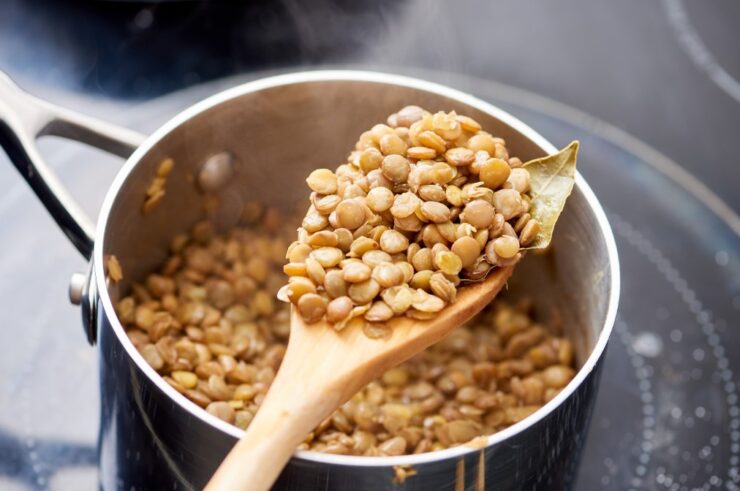There’s something incredibly comforting about a bowl of Spanish lentil stew. It’s one of those recipes that warms your hands, fills the kitchen with a cozy smell, and keeps everyone around the table just a little quieter than usual, because they’re too busy eating. In Spain, this dish is known as lentejas, and it’s been a family staple for generations. Packed with legumes, vegetables, and smoky meats, it’s honest food, humble but hearty.
Below, you’ll find a step-by-step traditional version of the Spanish lentil stew, just like it’s made in many Spanish homes. The ingredients are affordable, and once everything is simmering together, the flavors deepen into a stew that truly tastes like it was cooked with care.
Ingredients You’ll Need for Spanish Lentil Stew
This stew uses ingredients most people already have at home. The beauty of it is that it doesn’t need anything fancy to taste amazing. For a traditional stew that serves 4 to 6 people, you’ll need:
- 2 tablespoons olive oil
- 1 large onion, diced
- 2 garlic cloves, minced
- 1 green bell pepper, chopped
- 2 carrots, sliced
- 1 medium potato, peeled and cubed
- 200g chorizo sausage, sliced
- 1 teaspoon sweet paprika (Spanish if possible)
- 250g brown or Pardina lentils (rinsed, no soaking needed)
- 1 bay leaf
- Salt and black pepper to taste
- Water or low-sodium broth (about 1.5 liters)
Optional but recommended: a pinch of cumin and a splash of red wine vinegar right at the end for a flavor lift.

Source: recipesfromeurope.com
1. Start With a Solid Base ─ Sauté the Aromatics
Heat the olive oil in a deep pot or Dutch oven over medium heat. Once hot, add the onion and a pinch of salt. Let it soften for 5 minutes, stirring occasionally. Then, add the garlic, green pepper, and carrots. Cook this mix for another 4–5 minutes until everything smells rich and sweet.
The base of any stew is built here, on patience and slow cooking. It’s worth the time to let the vegetables caramelize just a bit. This is the step that makes your broth flavorful before you even pour in any water.
2. Bring in the Chorizo and Spices
Once your vegetables are well softened, stir in the chorizo slices. The fat from the sausage will release into the pot and flavor everything else. Add the paprika at this point, stirring constantly so it doesn’t burn. The aroma here is your sign, you’re on the right track.
This step is where that unmistakable Spanish flavor starts taking shape. The smoky spice of paprika, the oil from the sausage, this is the soul of the dish.
3. Adding Lentils and Liquid
Pour in your rinsed lentils, potatoes, bay leaf, and enough water or broth to generously cover everything. Raise the heat and bring it all to a boil. Then immediately reduce it to a gentle simmer.
Let the stew bubble gently for about 35 to 45 minutes, uncovered. Stir occasionally. The lentils should be tender but not mushy. If the liquid reduces too much, just add a bit more hot water.
During this simmering time, a lot happens. Flavors marry. Broth thickens slightly. That potato begins to break down just enough to make things creamy without cream.

Source: thekitchn.com
Final Touches and Taste Check
Before serving, taste the stew. Adjust salt and pepper, and if you like a little punch, add a dash of red wine vinegar. Some people also stir in a pinch of ground cumin for depth. It’s not traditional in every region of Spain, but it works beautifully here.
At this point, if the stew looks a bit thin for your liking, you can mash a few lentils and potatoes against the side of the pot and stir them in to thicken.
And if you’re ever curious whether your cooking has that human spark, especially when writing or sharing it online, tools like this AI detector free checker can be helpful, especially in professional kitchens that also publish recipes.
How to Serve It Right
You can ladle the stew straight into bowls and serve it as is, rustic, hearty, and satisfying. But here are a few extras that bring it all together:
- Crusty bread ─ Absolutely necessary for soaking up every last bit
- Side of olives or pickled onions ─ The tang complements the richness
- Splash of extra virgin olive oil ─ Adds a fresh finish on top
Leftovers are arguably even better the next day. Like many stews, the flavors deepen as it sits in the fridge overnight.
Recommendations:
- Use Pardina lentils if available, they hold their shape better
- Don’t overcook the chorizo in the early stage; just enough to release flavor
- Add the vinegar at the end, never at the beginning, to preserve its brightness
- Keep the bay leaf whole, so you can remove it easily before serving
- Let the stew rest 10 minutes before serving, it thickens slightly and cools down

Source: sbs.com.au
Final Thoughts
Spanish lentil stew isn’t just a recipe, it’s a tradition, something you’ll come back to again and again. It’s forgiving, nourishing, and filled with that old-school depth that modern meals often skip.
You can easily double the ingredients and freeze half for another week, and you can tweak it endlessly to suit your household. Once you get the hang of it, it practically cooks itself, leaving you time to focus on everything else life throws at you.
There’s no secret ingredient. Just time, good ingredients, and a little attention. That’s how great stews have always been made.




